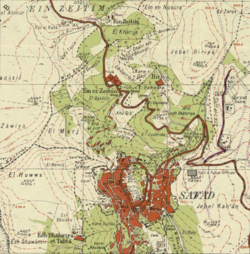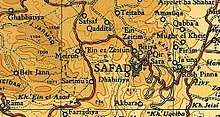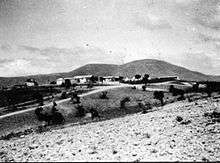Ein Zeitim
Ein Zeitim (Hebrew: עין זיתים, lit. Spring of Olives) was an agricultural settlement about 2 km north of Safed first established in 1891.[1]

History
.png)


Ein Zeitim was founded by members of the Dorshei Zion (Seekers of Zion) society, a Zionist pioneer group from Minsk.[2] Despite strong opposition by the Turkish government, the settlers managed to establish farms with olive groves, orchards and dairy and poultry.[3]
Ein Zeitim was built 800m north of the Arab village Ein al-Zeitun, which had commonly been called Ein Zeitim in Hebrew and had been a mixed Arab-Jewish village during the Middle Ages.[4]
In 1891 some speculators bought 430 hectares of land about 3 km north of Safed, and sold it to a party of laborers. Unable to work the land properly, the new owners transferred it to Baron de Rothschild, with whose assistance 750,000 vines and many fruit-trees were planted in the course of six or seven years, and during this time a number of houses were built. The population in 1898 was 51.[5]
The village was abandoned during the first World War and only a handful of residents returned at the end of the war.[6] The 1922 census of Palestine recorded a population of 37 inhabitants, consisting of 30 Jews and 7 Muslims.[7] During the 1929 Palestine riots, three residents were killed and the remainder left.[6] Six Muslims and one Jew were recorded there in 1931, living in four houses.[8] An attempt to revive the village in 1933 failed.[6]
_-_Building_Kibbutz_Ein_Zeitim.jpg)
In 1946 the village was reestablished after the Jewish National Fund acquired the land.[6] It had a population of 100 in 1947,[3] but by the end of 1951 the population had fallen to 40.[9] Eventually, it ceased to be populated and it became part of a military base.

References
- Jacob Goldstein (April 1998). From fighters to soldiers: how the Israeli defense forces began. Sussex Academic Press. pp. 9–. ISBN 978-1-902210-02-5. Retrieved 16 May 2011.
- Jewish rural settlement in Cyprus 1882–1935: A “springboard” or a destiny?
- Jewish National Fund (1949). Jewish Villages in Israel. Jerusalem: Hamadpis Liphshitz Press. pp. 40–41.
- Alex Carmel; Peter Schafer; Yossi Ben-Artzi (1990). The Jewish Settlement in Palestine, 634-1881. Wiesbaden : Reichert. p. 94.; for location, "Safad 1:100000" map by Dept. of Lands & Surveys, 1935.
- Herman Rosenthal (1901), "Agricultural Colonies in Palestine", Jewish Encyclopedia, Vol. 1
- "Three new villages in N. Palestine". Palestine Post. January 18, 1946. p. 1.
- J. B. Barron, ed. (1923). Palestine: Report and General Abstracts of the Census of 1922. Government of Palestine. p. 41 Table XI.
- E. Mills, ed. (1932). Census of Palestine 1931. Population of Villages, Towns and Administrative Areas. Jerusalem: Government of Palestine. p. 106.
- Government of Israel, Government Year-book 5713 (1952), Supplement page VI.
Further reading
- Frederick Martin; Sir John Scott Keltie; Isaac Parker Anderson Renwick; Mortimer Epstein; Sigfrid Henry Steinberg; John Paxton (1922). The Statesman's year-book. St. Martin's Press. pp. 1372–. Retrieved 16 May 2011.
- Arthur Koestler (1983). Promise and fulfilment: Palestine 1917-1949. Macmillan. ISBN 978-0-333-35152-9. Retrieved 16 May 2011.
- Fred Skolnik; Michael Berenbaum (2007). Encyclopaedia Judaica. Macmillan Reference USA in association with the Keter Pub. House. ISBN 978-0-02-865943-5. Retrieved 16 May 2011.
- J. Bowyer Bell (1969). The long war: Israel and the Arabs since 1946. Prentice-Hall. Retrieved 16 May 2011.